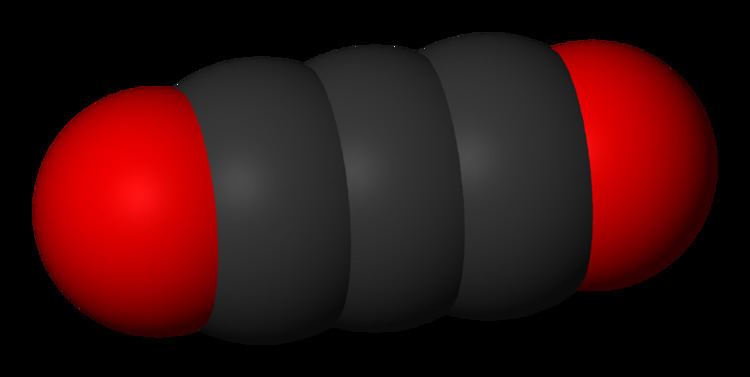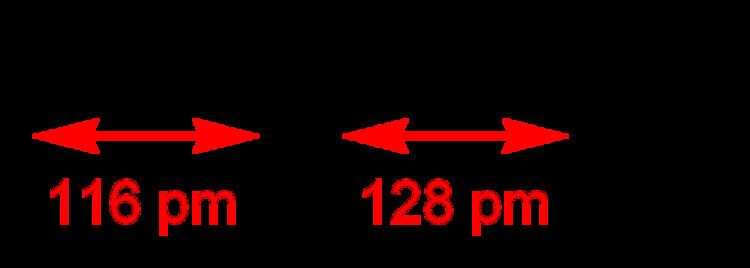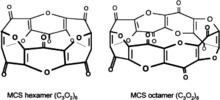Boiling point 6.8 °C Appearance colorless gas | Density 906 kg/m³ | |
 | ||
Related oxides Related compounds | ||
Chemical bonding carbon suboxide tutorial
Carbon suboxide, or tricarbon dioxide, is an oxide of carbon with chemical formula C3O2 or O=C=C=C=O. Its four cumulative double bonds make it a cumulene. It is one of the stable members of the series of linear oxocarbons O=Cn=O, which also includes carbon dioxide (CO2) and pentacarbon dioxide (C5O2).
Contents
- Chemical bonding carbon suboxide tutorial
- Carbon suboxide meaning
- Synthesis
- Uses
- Biological role
- Structure and Bonding
- References

The substance was discovered in 1873 by Benjamin Brodie by subjecting carbon monoxide to an electric current. He claimed that the product was part of a series of "oxycarbons" with formulas Cx+1Ox, namely C, C2O, C3O2, C4O3, C5O4, ..., and to have identified the last two; however only C3O2 is known. In 1891 Marcellin Berthelot observed that heating pure carbon monoxide at about 550 °C created small amounts of carbon dioxide but no trace of carbon, and assumed that a carbon-rich oxide was created instead, which he named "sub-oxide". He assumed it was the same product obtained by electric discharge and proposed the formula C2O. Otto Diels later stated that the more organic names dicarbonylmethane and dioxallene were also correct.

It is commonly described as an oily liquid or gas at room temperature with an extremely noxious odor.
Carbon suboxide meaning
Synthesis

It is synthesized by warming a dry mixture of phosphorus pentoxide (P4O10) and malonic acid or the esters of malonic acid. Therefore, it can be also considered as the anhydride of malonic anhydride, i.e. the "second anhydride" of malonic acid.

Several other ways for synthesis and reactions of carbon suboxide can be found in a review from 1930 by Reyerson.

Carbon suboxide polymerizes spontaneously to a red, yellow, or black solid. The structure is postulated to be poly(α-pyronic), similar to the structure in 2-pyrone (α-pyrone). In 1969, it was hypothesized that the color of the Martian surface was caused by this compound; this was disproved by the Viking Mars probes (the red color is instead due to iron oxide).
Uses

Carbon suboxide is used in the preparation of malonates; and as an auxiliary to improve the dye affinity of furs.
Biological role
Carbon suboxide, C3O2, can be produced in small amounts in any biochemical process that normally produces carbon monoxide, CO, for example, during heme oxidation by heme oxygenase-1. It can also be formed from malonic acid. It has been shown that carbon suboxide in an organism can quickly polymerize into macrocyclic polycarbon structures with the common formula (C3O2)n (mostly (C3O2)6 and (C3O2)8), and that those macrocyclic compounds are potent inhibitors of Na+/K+-ATP-ase and Ca-dependent ATP-ase, and have digoxin-like physiological properties and natriuretic and antihypertensive actions. Those macrocyclic carbon suboxide polymer compounds are thought to be endogenous digoxin-like regulators of Na+/K+-ATP-ases and Ca-dependent ATP-ases, and endogenous natriuretics and antihypertensives. Other than that, some authors think also that those macrocyclic compounds of carbon suboxide can possibly diminish free radical formation and oxidative stress and play a role in endogenous anticancer protective mechanisms, for example in the retina.
Structure and Bonding
The structure of carbon suboxide has been the subject of experimental and computation scrutiny since the 1970s. The central issue is the question of whether the molecule is linear or bent (i.e., whether θC2 = ∠C1-C2-C3 = 180°). Studies general agreed that the molecule is highly non-rigid, with a very shallow barrier to bending (< 0.5 kcal/mol for 140° ≤ θC2 ≤ 180°). While infrared and electron diffraction studies have indicated that C3O2 has a bent structure in the gas phase, the compound was found to possess a linear geometry in the solid phase by X-ray crystallography.
A heterocumulene resonance form of carbon suboxide based on minimization of formal charges does not readily explain the molecule's non-rigidity and deviation from linearity. To account for the quasilinear structure of carbon suboxide, Frenking has proposed that carbon suboxide be regarded as a "coordination complex" of carbon(0) bearing two carbonyl ligands and two lone pairs: OC→:C:←CO. However, the contribution of dative bonding in C3O2 and similar species has been criticized as chemically unreasonable by others.
